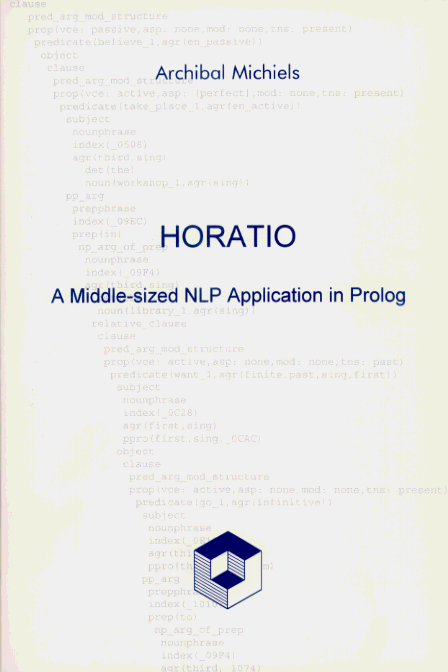|
Reviews
N. Curteanu (Iasi), Zentralblatt für Mathematik und ihre Grenzgebiete 863/97, p. 477.
HORATIO is a wonderful toy: a large and complex Prolog program devoted for both beginners
and experts in natural language (NL) processing (NLP) and Prolog programming. Archibal
Michiels provides the complete Prolog code for the NL analysis (HORATIO) and generation
(HORAGEN), this fact offering the unique opportunity for intensive learning of Prolog language,
in the context of NL grammar design, parsingstrategy, lexicon representation and organization,
generation algorithm, interaction between components of the grammar, various coding idioms
etc. The emphasis throughout the book falls on NL grammar writing, using standard Prolog
and standard DCG notation, and dealing with parsing and generation of "linguistic" rather
than "real-life" NL sentences. The interest of HORATIO focuses on explaining the strategies,
methods, and solutions, and how they are linked the NLP tasks. HORATIO is a lexicon-
driven and surface (thus syntactically) oriented system, the depth level of its parses being
more adequate to tasks such as machine translation between fairly closely related NLs. The
transformation of HORATIO from a pedagogical tool into a real-world system could be an
exiting challange to any NLP, Prolog team.
Michael A. Covington (University of Georgia), Computational Linguistics Vol. 22 Number 2 (1996), pp. 281-282.
HORATIO is a moderately-wide-coverage English parser developed in Arity Prolog on
a PC and based on Michael McCord's slot
grammars. Its output includes explicit grammatical relations such as subject and object, and some lexical disambiguation is
performed by using argument properties such
as human and abstract. Performance is respectable; on my 66-MHz 486, each sentence
in the test suite took no more than a few
seconds, including complex sentences such
as Devito manages a programmer Abrams interviewed and Browne hired.
Noteworthy features of HORATIO include a
lexicon derived (by the awk program) from
an on-line version of the Longman Dictionary
of Contemporary English; a parsing technique that avoids looping on coordinate structures;
provisions for idioms with different degrees
of syntactic opacity; a mechanism to handle
word-order variation; and a generation facil-
ity.
The book documents HORATIO in detail:
"No pseudo-code is given. No piece of code
is presented in a simplified form. Cited code
always corresponds exactly to the runnable
code to be found on the companion disk"
(p. 5). (1)
The diskette does indeed contain the
source code, executables, and test suite, entire. The user can verity that HORATIO works
as advertised, give it additional sentences to
parse, and use it as the basis of further work
(taking due note of the copyright, of course).
Porting from Arity Prolog to other implementations should be straightforward.-
(1) The code may also be downloaded free of charge from http://engdep1.philo.ulg.ac.be.
|
